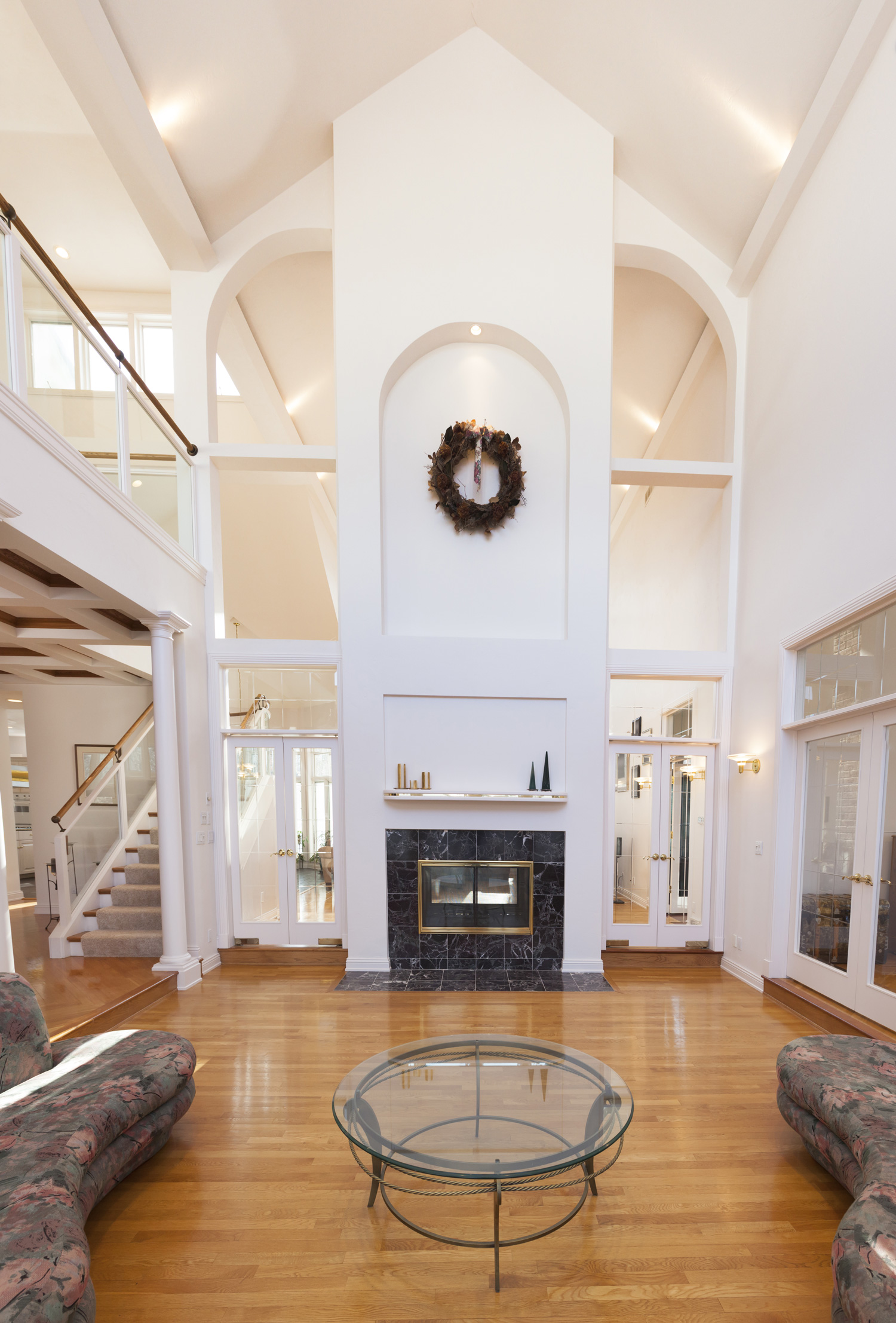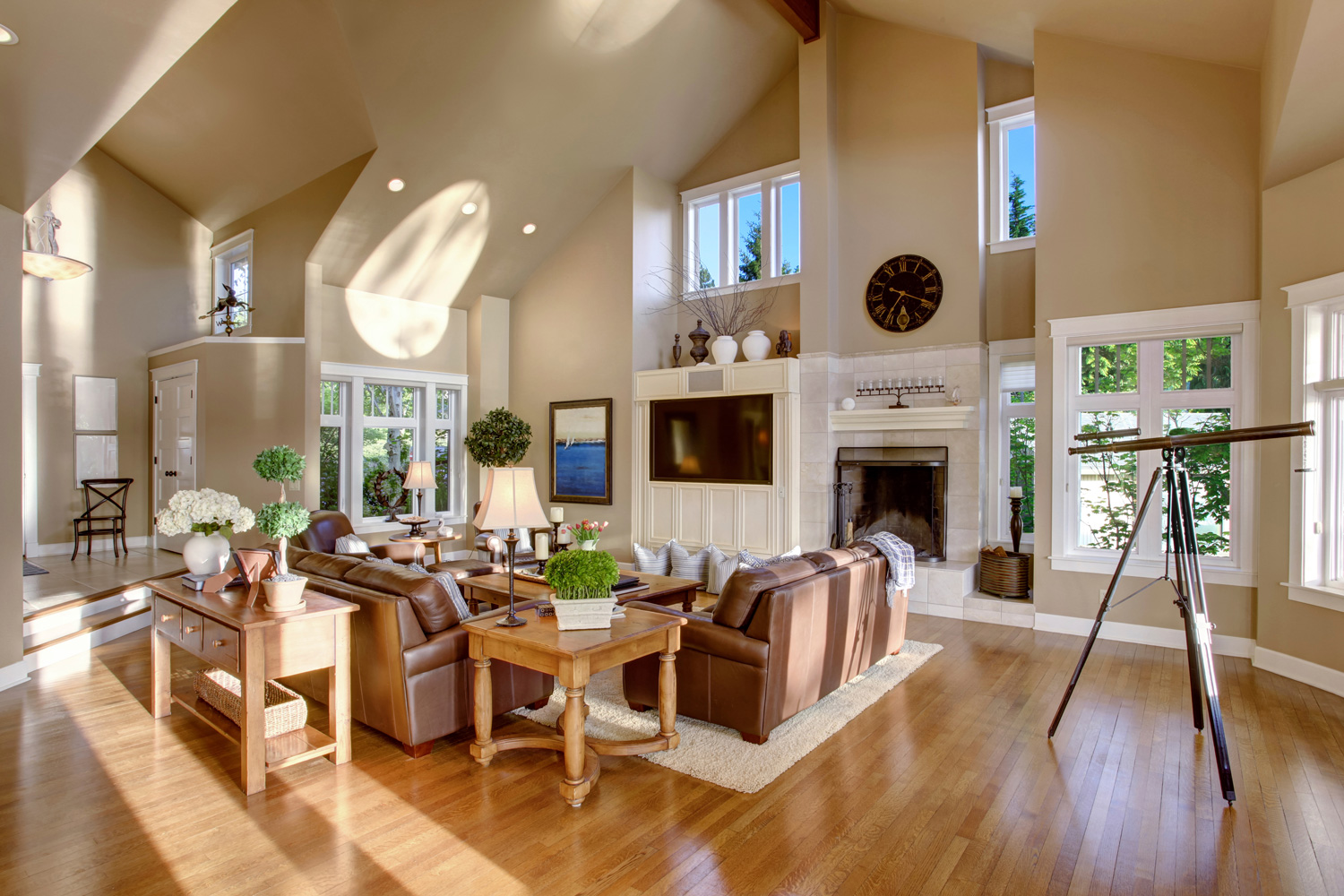Cathedral ceilings create a dramatic and spacious feeling. Whether their purpose is functional, to create the illusion of space, or purely for aesthetics, they have a grand look. We researched some amazing lighting ideas, so you can confidently brighten your home!
On average, modern homes have 9-foot ceilings. However, cathedral ceilings are an average height of 12 or 13 feet, which requires ample lighting. Check out the following lighting ideas for a cathedral ceiling, as listed below.
- Recessed Spot Lights
- Low Hanging Pendants
- Sky Lights
- Repeat Lighting
- Natural
- Intricate Chandelier
- Rustic Chandelier
- Combination
Cathedral ceilings provide plenty of room to design the perfect lighting for your ideal space. With spacious ceilings, you can get creative and achieve your dream lighting effect. Check out our list below for inspiration, so you can take your cathedral ceilings to the next level.

Lighting Ideas To Explore
1. Recessed Spot Lights
We sometimes add affiliate links and content that was curated and created by our team with the help of advanced ai tools to help showcase the best design styles.

Recessed lights are great for higher ceilings for several reasons. They stay relatively clean since they aren't hanging around collecting dust.
They may allow you to direct light into specific areas of the room where you need it most. So, you can create an evenly lighted space or concentrate light on a main area.
2. Low Hanging Pendants

Pendant lights are a great way to light specific areas, like kitchen islands or dining room tables. Since pendants are individual hanging lights, you can select the number and spacing you need for a specific area.
With countless designs, you have complete control over how you want your lighting to look and feel.
3. Sky Lights

For cathedral ceilings, natural light is the most beautiful way to brighten the space.
Skylights bring natural light in from above, ensuring you won't have dark spots in the upper levels of the room. You also get a clear view of the sky, unobstructed by other houses or structures.
Since cathedral ceilings follow the slope of the roof, skylights are fairly easy to have installed by professionals.
4. Repeat Lighting

When selecting lighting for a room with high ceilings, you may need to have more light fixtures than you would in a smaller room with a lower ceiling.
If you want to keep your lighting closer to average height, like on the walls, surrounding the room will help bring light into a larger space.
Finding a light fixture you love and using it around the entire room will tie together the space without overwhelming it. This bathroom uses different variations of the same light fixtures to bring light into the area and still keep a cohesive style.
5. All Natural

High ceilings often mean high walls, which gives you the perfect opportunity to fill a wall or two with windows. Floor to ceiling natural light will help illuminate even the tallest and widest of spaces. And it looks beautiful.
There are also tons of ways to be creative when choosing how to incorporate windows into the space. Consider a wall mostly covered in windows, like pictured above, or an entire wall that is a window, like below.

You can even get creative with different shapes and spacing for windows.

Remember, be careful when deciding on using large and many windows. They can make heating and cooling your home more expensive if you live in regions with extreme temperatures.
6. Intricate Chandelier

For a more elegant look, detailed chandeliers are a stunning addition to cathedral ceilings. The tall space can handle large, hanging, and intricately designed light fixtures.
You can achieve a similar look with a large, highly detailed chandelier.
7. Rustic Chandelier

If you love the idea of a chandelier but desire a more tame design, simple and rustic lighting is perfect for you.
Chandeliers like the one pictured above, provide an elegant and dramatic statement, without taking over the main focus of the room. It's classy, simplified, and still brings an ample amount of lighting into the room.
8. Perfect Combination

Cathedral ceilings, depending on the height of the room, might be hard to light properly. A great way to combat rooms like this is to choose a combination of lights that suit the area.
Recessed lighting is a subtle way to brighten higher areas of the room without taking up much space. From there, you can choose pendant lights or chandeliers that work for your design or aesthetic.
What Is The Difference Between A Cathedral And A Vaulted Ceiling?
Although it's common to use 'cathedral' and 'vaulted' interchangeably, they are actually very different. Both describe higher than average ceilings, often with sloping sides. However, that's where the similarities stop.
Cathedral ceilings specifically follow the slope of the roof of the structure. You won't find cathedral ceilings on the first floor with rooms above them.
The ceilings inside will mimic the roof just on the outer side, often being two slopes reaching toward a middle point.

Vaulted ceilings have fewer rules to follow. Their height and shape do not follow the slope of the roof, so therefore, they can be on any floor in a home. They can contain combinations of slopes and flat areas in any design.

What Are The Advantages Of A High Ceiling?
Here are some of the most popular advantages of having a home with high ceilings. See below.
Space
There are a lot of interior design tricks out there that work to create the illusion of more space in a smaller room. More space gives the look and feel of luxury in a home, which makes it a sought-after commodity.
High ceilings, even in a small room, add drama and grandeur. Where you may spend money on trying to make a room look larger, you can use dynamic lighting to take advantage of that space.
Light

As we mentioned before, windows are a beautiful source of lighting for cathedral ceilings. Higher ceilings allow for larger windows in the lower half of the room, bringing in more natural light.
Once again, natural light creates more visual space in a room, making it appear larger.
Aesthetics
Simply put, high ceilings are dramatic. Even minimalistic decor can't take away from the impact they bring to a room. High ceilings don't need a bunch of dressing up to be appealing, they just are.
If you decide to dress up your ceilings, there are countless ways to take advantage of that space aesthetically. Decorating ceiling slopes with darker paint or even printed wallpaper will make quite the bold statement.
You can play up the area below the slopes with intricate patterns and designs. And the high ceilings will help to create a neutral balance in what would otherwise overstimulate the decor.
Disadvantages Of High Ceilings
However, there are some downsides to high ceilings. See the following points below.
Cleaning

High ceilings that contain beams, high light fixtures, and other design elements that can gather dust over time can be a serious drawback for homeowners.
It can take a very tall ladder and a ton of courage to get into those nooks and crannies. You make also feel more comfortable hiring professionals, which can be costly.
When choosing to have cathedral or vaulted ceilings, as well as when deciding on lighting, consider your ability to clean the space. If it's more effort or trouble than it's worth, reconsider.
Lighting
We've talked a lot about lighting for high ceilings, but something to consider is exactly how much lighting you need for your specific space.
If your house doesn't have a lot of natural light or you are looking to illuminate a very large and tall space, you may need to invest in more lighting than you think.
This can be costly, especially if you must install fixtures where there weren't before. Between buying lights and hiring an electrician to install them, you could end up with a high bill.
Heating and Cooling
Speaking of a high bill, vaulted and cathedral ceilings can lead to higher energy bills as well. Heating and cooling larger spaces take more energy as it is.
When that heat and air are going into unused air space, it can take even longer to reach the desired temperature in your home.
Are Cathedral Ceilings Outdated?

Cathedral ceilings are classic and timeless. They likely won't ever go out of style.
However, that doesn't mean that everyone loves cathedral ceilings. For some, the height of the ceilings can be overwhelming or unnecessary. Others may find that it dates a home.
Cathedral ceilings were a popular element in the '80s and '90s, which differs from recent contemporary home designs.
Still, rustic and farmhouse designers use them regularly. And they carry a lot of weight in interior design. Some simply don't enjoy them and see them as a polarizing issue.
In Conclusion
Cathedral ceilings look luxurious and provide the perfect canvas for a variety of lighting options. From large and intricate chandeliers to delicate pendant lights, they can handle anything.
If you want to explore more on lighting and high ceilings, check out these posts:
How To Light A Room That Has No Overhead Lighting [7 Alternatives]



